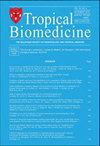植物精油对本土特征的耐甲氧西林金黄色葡萄球菌(MRSA)的抑菌活性。
IF 0.8
4区 医学
Q4 PARASITOLOGY
引用次数: 2
摘要
研究了植物精油对耐甲氧西林金黄色葡萄球菌(MRSA)的抑菌活性。分离株(n=03)来源于巴基斯坦拉合尔大学微生物研究所。经生化和基于16S rRNA基因的PCR鉴定后,从NCBI中检索加入号为MW344063.1、MW344064.1和MW344065.1。经多重PCR检测,这些分离物的mecA、coa和eta毒素基因均呈阳性。此外,这些分离株对头孢西丁、氨苄西林、阿莫西林、青霉素、克拉维酸阿莫西林、环丙沙星、红霉素和庆大霉素均表现出耐药性。研究了耐药菌株对植物精油的抑菌活性。抑制区(平均ZOI±S.D.)最高的是verum Cinnamomum verum(22.67±1.52 mm),其次是Eucalyptus globulus(18.67±2.51 mm)和Syzygium aromaticum(12.67±2.51 mm)。平均MIC值最低(0.33±0.11 mg/mL)。采用柱层析法对蓝桉进行分离处理,并对正己烷、氯仿、正己烷+氯仿和乙酸乙酯组分进行抑菌活性评价。正己烷部分最低平均MIC(10.04±5.80 mg/mL)。在54.87mg/mL正己烷浓度下,BHK21细胞株的细胞存活率为51.7%。通过气相色谱-质谱(GC-MS)对正己烷馏分进行分析,发现苯含量丰富(29.9%)。结果表明,球芽胞杆菌正己烷馏分对MRSA具有较好的抑菌效果。本文章由计算机程序翻译,如有差异,请以英文原文为准。
Antibacterial activity of plant essential oils against indigenously characterized methicillin-resistant Staphylococcus aureus (MRSA).
Plant essential oils were evaluated for antimicrobial activity against Methicillin-resistant Staphylococcus aureus (MRSA). The isolates (n=03) were procured from Institute of Microbiology, UVAS Lahore, Pakistan. After biochemical and 16S rRNA gene-based PCR characterization, accession numbers were retrieved from NCBI i.e. MW344063.1, MW344064.1 and MW344065.1. These isolates exhibited molecular positivity by multiplex PCR for mecA, coa and eta toxin genes. Moreover, these isolates exhibited resistance to cefoxitin, ampicillin, amoxicillin, penicillin, amoxicillin clavulanate, ciprofloxacin, erythromycin and gentamicin. The antibiotic resistant isolates were evaluated for antimicrobial activity of plant essential oils. The highest zone of inhibition (mean ZOI±S.D.) was measured for Cinnamomum verum (22.67±1.52 mm) followed by Eucalyptus globulus (18.67±2.51 mm) and Syzygium aromaticum (12.67±2.51 mm). Lowest mean MIC value (0.33±0.11 mg/mL) was recorded for E. globulus . Eucalyptus globulus was processed for fractionation by column chromatography and n-hexane, chloroform, n-hexane + chloroform and ethyl-acetate fractions were evaluated for antibacterial activity. Lowest mean MIC (10.04±5.80 mg/mL) was recorded for E. globulus n-hexane fraction. Cell survival percentage of BHK21 cell line was 51.7% at 54.87mg/mL concentration of E. globulus n-hexane fraction. Through gas chromatography-mass spectrometry (GC-MS) analysis of n-hexane fraction, benzene was found abundant (29.9%) as active compound. It was concluded that E. globulus n-hexane fraction exhibited significantly promising results against MRSA .
求助全文
通过发布文献求助,成功后即可免费获取论文全文。
去求助
来源期刊

Tropical biomedicine
医学-寄生虫学
CiteScore
1.60
自引率
0.00%
发文量
63
审稿时长
6-12 weeks
期刊介绍:
The Society publishes the Journal – Tropical Biomedicine, 4 issues yearly. It was first started in 1984. The journal is now abstracted / indexed by Medline, ISI Thompson, CAB International, Zoological Abstracts, SCOPUS. It is available free on the MSPTM website. Members may submit articles on Parasitology, Tropical Medicine and other related subjects for publication in the journal subject to scrutiny by referees. There is a charge of US$200 per manuscript. However, charges will be waived if the first author or corresponding author are members of MSPTM of at least three (3) years'' standing.
 求助内容:
求助内容: 应助结果提醒方式:
应助结果提醒方式:


